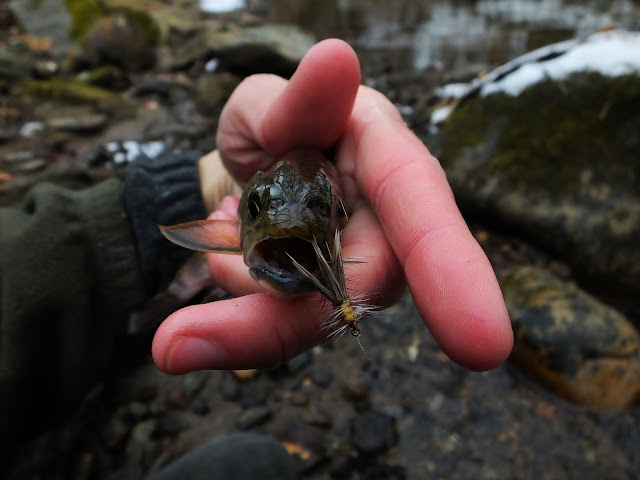February is the last of the three really tough months to get a trout on a dry fly. March can by difficult but it usually isn't as bad as December, January, or February. If you can knock those three months out you can catch trout on dries any month of the year. Today, the 1st of February, was fairly warm with minimal wind and good water flows and temperatures on the local streams. I felt like I had just been thrown a bone! I could knock out February in one day.
I could have done it in the first pool, actually. But I was not paying attention when a brookie came up and took my black Klinkhammer and missed my chance. I left that stream without a fish. The next one as well.
The third stream gave me an opportunity to try for a sea run brown, so I did for an hour or so with a very unsurprising lack of takes.
Then I went to a big flat pool that has been responsible for the crossing off of two previous months in my dry fly quest. With a large parachute Adams the deed was done, and I released the kind brookie that confirmed my 36th month and third full year of dry fly salmonids. I caught another on a yellow stimulator and a third on the Adams again. And with that I said goodbye. I could have fished two or three more pools, maybe more. But I had done what I came to do and didn't want to give the stream undue pressure. The challenge continues.









I dont know why, but I've never thought of an all black Klink! That's a great idea - I'm going to have to make some. Your photo's are always awesome, and that cardinal and the waterfall, as well as the clear water... Wow. The brookies are good as well! Congrats on the dry fly fish so early!
ReplyDeleteThanks.
DeleteThe black klinkhammer... a necessary autumn and winter dry fly.
Rowan you found some very willing fish. My day was the opposite. Three hours and two browns.
ReplyDeleteStill haven't seen early stones.
The tiniest snow flies have been about for a couple weeks. Takes a keen eye to spot them, they are best imitated with a sz. 22 fly.
DeleteWhat is this? HAtched las t weekedn in Chatfield schreeder pond:
Deletehttps://3.bp.blogspot.com/-Sotz1Plp7_A/Wm38MY76sgI/AAAAAAAAEvQ/UAu1EkoyTEo2NFpbapb6FpT8ZBDEShLFwCLcBGAs/s1600/26061179248_e14fcf51b4_o.jpg
That would be a snowfly or winter stone, exactly what Alan and I are talking about... notice that his wings are shorter than his body. They are actually unable to fly at that stage but will march hundreds of feet away from the stream on snow or ice.
DeleteCool--that's what I thought:-)
DeleteLast year I saw tons --- TONS -- of them crawling all over the snow on the Hammonasset.
Today's hatch (4 Feb) on the Hammonasset:
Deletehttps://c1.staticflickr.com/5/4706/39190793285_0dcffcbb1d_o.jpg
Larger winter stones. On rivers with more wild fish those bugs usually start a good afternoon rise.
DeleteGreat start for Feb. I'm sure it won't be your last as the stones will continue to hatch.
ReplyDeleteTie, fish, write and photo on...
They hadn't really started on these stream and probably still haven't.
Delete